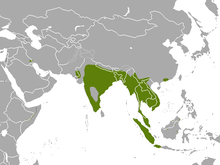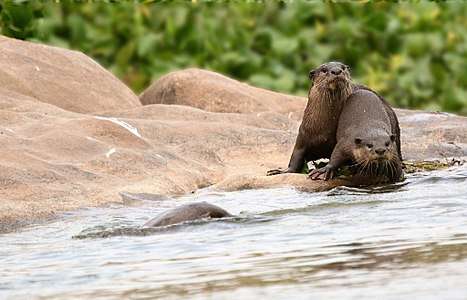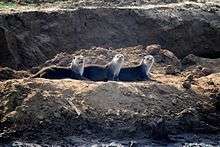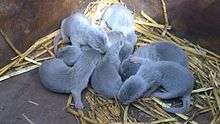Smooth-coated otter
| Smooth-coated otter | |
|---|---|
.jpg) | |
| A smooth-coated otter photographed in Borneo, Malaysia | |
| Scientific classification | |
| Kingdom: | Animalia |
| Phylum: | Chordata |
| Class: | Mammalia |
| Order: | Carnivora |
| Family: | Mustelidae |
| Subfamily: | Lutrinae |
| Genus: | Lutrogale |
| Species: | L. perspicillata |
| Binomial name | |
| Lutrogale perspicillata (Geoffroy Saint Hilaire, 1826) | |
 | |
| Smooth-coated otter range | |
| Synonyms | |
|
Lutra perspicillata | |

The smooth-coated otter (Lutrogale perspicillata) is a species of otter, the only extant representative of the genus Lutrogale. The species is found in most of the Indian subcontinent and eastwards to Southeast Asia, with a disjunct population in Iraq.[1] As its name indicates, the fur of this species is smoother and shorter than that of other otter species.
Characteristics
Smooth-coated otters are relatively large for otters, from 7 to 11 kg (15 to 24 lb) in weight and 59 to 64 cm (23 to 25 in) in head-body length, with a tail 37 to 43 cm (15 to 17 in) long. They may be distinguished from other species of otters by a more rounded head and a hairless nose in the shape of a distorted diamond. The tail is flattened, in contrast to the more rounded tails of other species. The legs are short and strong, with large webbed feet bearing strong claws. As their name suggests, they have unusually short and sleek fur; this is dark to reddish brown along the back, while the underside is light brown to almost grey in color. Females have two pairs of teats.[2]
Distribution and habitat
The smooth-coated otter has been recorded in Pakistan, India, Nepal, Bhutan, Bangladesh, southwest China, Myanmar, Thailand, Vietnam, Malaysia, Indonesian islands of Borneo, Sumatra, Java and Brunei. An isolated population is also found in the marshes of Iraq.[1]
It occurs in areas where fresh water is plentiful — wetlands and seasonal swamps, rivers, lakes, and rice paddies. Where only otter species occurs, the smooth-coated otter lives in almost any suitable habitat, but where it is sympatric with other otter species, it avoids smaller streams and canals in favour of larger water bodies.[2] Although it is often found in saltwater near the coast, especially on smaller islands, it requires a nearby source of fresh water.[3]
There are three recognised otter subspecies:[2]
- L. p. perspicillata – most of India, Nepal, southwestern Yunnan, most of Southeast Asia, Sumatra, Java
- L. p. maxwelli – southern Iraq
- L. p. sindica – Sind, Pakistan
Fossils belonging to the genus Lutrogale are known from the early Pleistocene in Java. Two fossil species, an earlier form, L. robusta, and the more recent L. palaeoleptonyx, are known. They probably fed primarily on shellfish, rather than on fish as the current species does.[2]
Ecology and behavior

.jpg)

Smooth-coated otters are social and hunt in groups.[3] They are mainly diurnal, and have a short lull in activity during midday.[4]
They spend the night in dens dug in dense vegetation, under tree roots, or among boulders. They use scent to communicate both within the otter species, and with other animals. Each otter possesses a pair of scent glands at the base of the tail which are used to mark land or objects, such as rocks or vegetation, near feeding areas in a behavior called sprainting. They also communicate through vocalisations such as whistles, chirps, and wails.[2]
Some may construct permanent holts near water, in a layout similar to that of a beaver dam, with an underwater entrance and a tunnel that leads to a nest above the water.
Fish comprise over 70% of their diet, but they also eat reptiles, frogs, insects, crustaceans, and small mammals.[3] Especially in areas where other species of otter are also found, they prefer larger fish, typically between 5 and 30 cm (2.0 and 11.8 in) in length.[3][5] They sometimes hunt in groups of up to 11 individuals.[2]
In the Kuala Selangor Nature Park, an otter group was observed hunting. They formed an undulating, slightly V-shaped line, pointing in the direction of movement and nearly as wide as the creek. The largest individuals occupied the middle section. In this formation, they undulated wildly through the creek, causing panic‑stricken fish to jump out of the water a few metres ahead. They suddenly dived and grasped the fish with their snouts. Then they moved ashore, tossed the fish up a little on the muddy part of the bank, and swallowed it head‑first in one piece.[6]
A group of otters can have a feeding range of 7 to 12 km2. A single adult consumes about 1 kg of food per day in captivity.
Reproduction

Smooth-coated otters form small family groups of a mated pair with up to four offspring from previous seasons.[7] Copulation occurs in water and lasts less than one minute.[8]
So long as the food supply is sufficient, they breed throughout the year, but where otters are dependent on monsoons for precipitation, breeding occurs between October and February. A litter of up to five pups is born after a gestation period of 60 to 63 days.[2] However, on 14 June 2014, a smooth-coated otter called Ping at Wingham Wildlife Park in the UK gave birth to a litter of seven young.[9] The mothers give birth to and raise their young in a burrow near water. They may either construct such a burrow themselves, or they may take over an abandoned one. At birth, the pups are blind and helpless, but after 10 days, their eyes open, and they are weaned at about three to five months. They reach adult size at about a year of age, and sexual maturity at two or three years.[2]
In Singapore, it was discovered that female Asian small-clawed otters interbred with male smooth-coated otters, resulting in the first documented case of hybridization between otter species in the wild. The resulting offspring and their descendants bred back into the smooth-coated otter population, but maintained many of the genes found in their small-clawed otter ancestors. Today, a population of at least 60 of these hybrid otters exists in Singapore, but the question remains as to how widespread the hybridization is between these two species actually is, and the resulting effects it has.[10]
Threats
Major threats to Asian otter population are loss of wetland habitats due to construction of large-scale hydroelectric projects, reclamation of wetlands for settlements and agriculture, reduction in prey biomass, poaching, and contamination of waterways by pesticides. In most Asian countries, increased human population during the last century, inadequate and ineffective rural development programmes have not been able to address the problems of poverty, forcing people to be more and more dependent on natural resources. Consequently, most of the wetlands and waterways do not have adequate prey base for sustaining otter populations. Wetlands and waterways are polluted by eutrophication and accumulation of persistent pesticides such as chlorinated hydrocarbons and organophosphates through agricultural runoffs. Increased pesticide use is not only regarded as a major obstacle to the development of rice-fish culture, but also poses a danger to all predators feeding on aquatic prey in the area. In the entire South and Southeast Asia, severe conflict exists between otters and humans, because of poverty and recent increases in aquaculture activities leading to indiscriminate killing of otters. Many important habitats of smooth-coated otters have been lost to development activities. In Southeast Asian countries, intentional otter trapping does not seem to occur, though it is prevalent in India, Nepal, and Bangladesh.[1]
Due to the draining of the Mesopotamian Marshes during the presidency of Saddam Hussein, the Iraqi population of otters was feared to have perished. A biodiversity site review in 2009 found tracks of an otter, suggesting the population may have survived,[11] and comprehensive surveys in 2005–2012 found that it survived at several locations (even extending its range to Iraqi Kurdistan, far north of its previously known distribution).[12]
Conservation
Lutrogale perspicillata has been listed on CITES Appendix II since 1977. It is a protected species in almost all the range countries, which prohibits its killing. Most range countries are not able to control the clandestine trade leading to extensive poaching.[1]
The smooth-coated otter is listed as a vulnerable species. Their range and population are shrinking due to loss of wetland habitat and contamination of waterways by pesticides. The otters are protected in India under the Wildlife (Protection) Act, 1972.
Smooth-coated otters are used for commercial fishing in southern Bangladesh. These otters are bred in captivity, trained, and used to chase fish into fishing nets. This fishing technique is currently used by about 300 fishermen, with an additional 2,000 people indirectly dependent on the technique for their livelihood.[13]
Otters studied along the Chambal River in India have shown to be most vulnerable during winter due to their breeding habits and rearing of young in these months. Currently human presence is noted to be highest during these months due to the local winter crops. The otters are shown to be highly disturbed in the presence of humans, making counting through spraint detection, tracks, and visual sightings hard to give accurate population numbers in conservation studies in India. Smooth-coated otters have been given some protection along the Chambal River under protection stated for local aquatic fauna, but continual effort to protect them includes prohibition of tree removal along rocky stretches along river sides.[14]
References
- 1 2 3 4 5 de Silva, P.; Khan, W.A.; Kanchanasaka, B.; Reza Lubis, I.; Feeroz, M.M. & Al-Sheikhly, O.F. (2015). "Lutrogale perspicillata". The IUCN Red List of Threatened Species. IUCN. 2015: e.T12427A21934884. doi:10.2305/IUCN.UK.2015-2.RLTS.T12427A21934884.en. Retrieved 15 January 2018.
- 1 2 3 4 5 6 7 8 Hwang, Y. T. & Larivière, S. (2005). "Lutrogale perspicillata" (PDF). Mammalian Species. 786: 1–4. doi:10.1644/786.1.
- 1 2 3 4 Kruuk, H.; Kanchanasaka, B.; O'Sullivan, S.; Wanghongsa, S. (1994). "Niche separation in three sympatric otters Lutra perspicillata, L. lutra and Aonyx cinerea in Huai Kha Khaeng, Thailand". Biological Conservation. 69 (1): 115–120. doi:10.1016/0006-3207(94)90334-4.
- ↑ Foster-Turley, P. (1992). Conservation aspects of the ecology of Asian small-clawed and smooth otters on the Malay Peninsula. International Union for the Conservation of Nature, Otter Specialist Group Bulletin 7: 26–29.
- ↑ Anoop, K. R. & Hussain, S. A. (2005). "Food and feeding habits of smooth-coated otters (Lutra perspicillata) and their significance to the fish population of Kerala, India". Journal of Zoology. 266 (1): 15–23. doi:10.1017/S0952836905006540.
- ↑ Helvoort, B. E. van; Melisch, R.; Lubis, I. R. & O'Callaghan, B. (1996). "Aspects of Preying Behaviour of Smooth Coated Otters Lutrogale perspicillata from Southeast Asia". IUCN Otter Specialist Group Bulletin. 13 (1): 3–7.
- ↑ Hussain, S. A. (1996). Group size, group structure and breeding in smooth-coated otter Lutra perspicillata Geoffroy in National Chambal Sanctuary. Mammalia 60: 289–297.
- ↑ Badham, M. (1973). "Breeding the Indian smooth otter Lutrogale perspicillata sindica X L.p. perspicillata at Twycross Zoo". International Zoo Yearbook. 13 (1): 145–146. doi:10.1111/j.1748-1090.1973.tb02132.x.
- ↑ "Wingham Wildlife Park Facebook Page". Wingham Wildlife Park. 2014-07-14. Retrieved 2014-09-07.
- ↑ Hong, S. (2018). Surprising branch in Singapore's otter family tree. The Straits Times, Singapore.
- ↑ Salim, M (2009). "Key Biodiversity Survey of Southern Iraq" (PDF). Nature Iraq. Retrieved 15 April 2013.
- ↑ Al-Sheikhly, O.F.; and Nader, I.A. (2013). The Status of the Iraq Smooth-coated Otter Lutrogale perspicillata maxwelli Hayman 1956 and Eurasian Otter Lutra lutra Linnaeus 1758 in Iraq. IUCN Otter Spec. Group Bull. 30(1).
- ↑ Feeroz, M. M., Begum, S. and Hasan, M. K. (2011). "Fishing with Otters: a Traditional Conservation Practice in Bangladesh". Proceedings of XIth International Otter Colloquium. IUCN Otter Specialist Group Bulletin (28A): 14–21.
- ↑ Hussain, S. A., Choudhury, B. C. (1997). "Distribution and status of the Smooth-coated Otter Lutra perspicillata in National Chambal Sanctuary, India". Biological Conservation. 80 (2): 199–206. doi:10.1016/S0006-3207(96)00033-X.
External links
| Wikimedia Commons has media related to Lutrogale perspicillata. |
| Wikispecies has information related to Lutrogale perspicillata |
